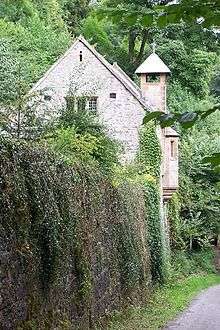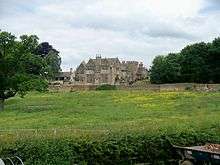Guy Dawber
Sir Edward Guy Dawber, RA (King's Lynn, 3 August 1861 – London, 24 April 1938) was an English architect working in the late Arts and Crafts style, whose work is particularly associated with the Cotswolds.
Sir Edward Guy Dawber | |
|---|---|
| Born | 3 August 1861 King's Lynn, Norfolk, England |
| Died | 24 April 1938 (aged 76) London, England |
| Occupation | Architect |
| Awards | RIBA Gold Medal, 1928, RA |
| Buildings | Eyford Park |
| Projects | Batsford Park |

Biography


Edward Guy Dawber was born in Britain in 1861, at King's Lynn, Norfolk, the son of John Stockdale Dawber (d. 1898) and his wife Lois Ellen (née Edwards). He trained in the practice of Sir Ernest George and Harold Peto, supervising their work on Batsford Park (1887–93), near Moreton-in-Marsh, in the Cotswolds.
In 1896 he married Mary Eccles in Lancashire.
In 1897 Dawber designed St John the Baptist's Chapel, Matlock Bath in Matlock Dale, Derbyshire, when he lived locally. It was the only church designed by him.[1]
Dawber designed the Old Post Office at 25 High Street, Broadway, Worcestershire, which was built in Cotswold stone by Espley & Co of Evesham in 1899 and opened on Friday 1 December 1899.[2] He also designed Bibsworth House, Broadway.
Working in the Cotswold vernacular tradition, Dawber became a respected and scholarly architect, designing and converting houses such as Nether Swell Manor (1903 and 1909) and Eyford Park (1911–12), both near Stow-on-the-Wold. In 1905 Batsford published Dawber's Old Cottages, Farm-houses and other Stone Buildings in the Cotswold District.
He also specialised in laying out and designing gardens.
From 1925 to 1927 Dawber was President of the Royal Institute of British Architects. In 1928 he was awarded the RIBA Royal Gold Medal.
In 1926 he played a prominent part in establishing the Council for the Preservation of Rural England, and became its first President. In that year he worked on the design of the Reptile House at London Zoo, Regent's Park, opened in 1927.
About 1928 he designed many buildings of Lord Wandsworth College, Hampshire.
He was knighted in 1936.
He died in London on 24 April 1938; he is buried at St Giles's church with his parents and brother.
Dawber also painted in watercolour.
Works
- Nether Swell Manor, Gloucestershire.
- St John the Baptist's Chapel, Matlock Bath, Derbyshire. Grade II* Listed,[3]
War memorials
- Moreton-in-Marsh and Batsford War Memorial, Cotswold, Gloucestershire. Grade II Listed[4]
- Northiam War Memorial, East Sussex. Grade II Listed[5]
- Long Wittenham War Memorial, Oxfordshire. Grade II Listed[6]
- Wallingford War Memorial, Oxfordshire. Grade II Listed[7]
References
- Historic England (2011). "Chapel of St John the Baptist Supporting retaining wall and attached boundary walls, Matlock Bath (1248139)". National Heritage List for England. Retrieved 18 May 2011.
- Evesham Standard & West Midland Observer, Saturday 9 December 1899.
- https://historicengland.org.uk/listing/the-list/list-entry/1248139
- https://historicengland.org.uk/listing/the-list/list-entry/1170425
- https://historicengland.org.uk/listing/the-list/list-entry/1393848
- https://historicengland.org.uk/listing/the-list/list-entry/1047906
- https://www.iwm.org.uk/memorials/item/memorial/2202
Further reading
- A chapter on him in: Reilly, Charles Herbert: Representative British architects of the present day. London: Batsford, 1931.
- Obituary notices published in: AA Journal vol 53, May 1938, p 522; Architect & Building News vol 154, 29 Apr 1938, p 112, 114, 155; Architect & Building News vol 155, 15 July 1938, p 61; Architect's Journal vol 87, 28 Apr 1938, p 685, 691; The Builder vol 154, 29 Apr 1938, p 824, 827; RIBA Journal vol 45, 1938, p 631, 633, 666-7, 720; The Times, Monday 25 Apr 1938